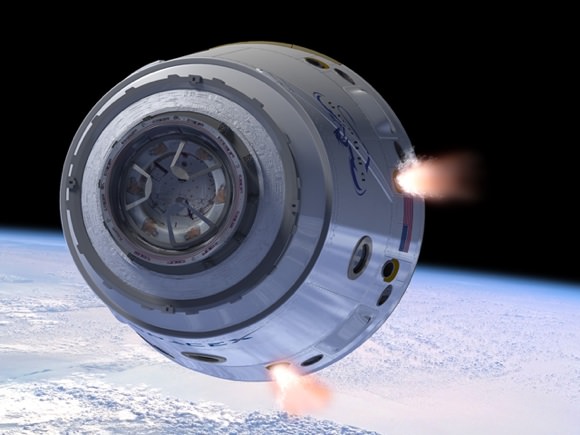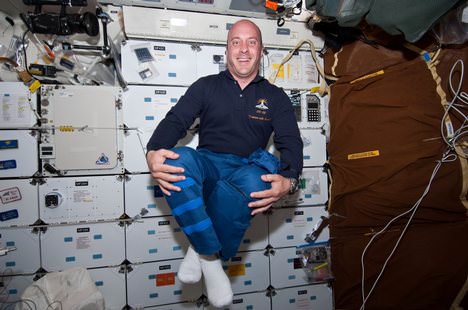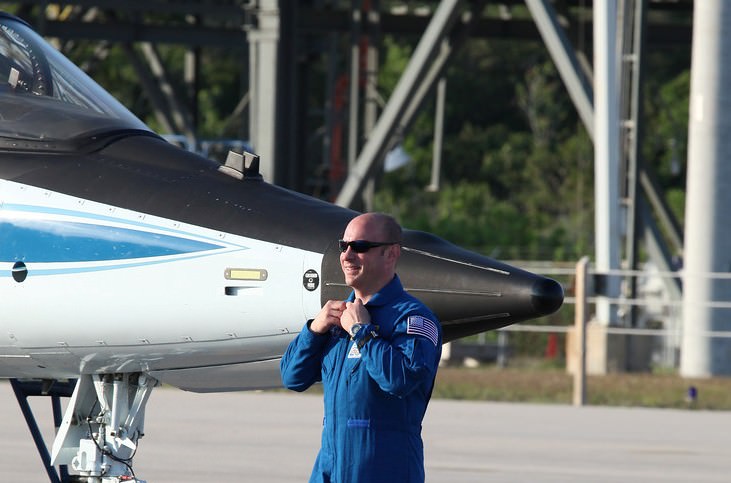[/caption]
CAPE CANAVERAL Fla. – Garrett Reisman knows a thing or two about what it takes to send astronauts to orbit. He should, he has taken the trip himself – twice. Reisman spent three months on the International Space Station launching with the STS-123 crew, and was a Mission Specialist on STS-132. He has walked in space, operated Canada’s Dextre robot and installed critical flight hardware to the ISS.
He has since left NASA to work for Space Exploration Technologies (SpaceX). Reisman took a moment to chat with Universe Today just before the final launch of the shuttle program, STS-135, on the orbiter Atlantis. Reisman spoke about SpaceX’s contract with NASA under the second phase of the Commercial Crew Development contract or CCDev-02, his new role as Director of SpaceX’s Dragon Rider program and whether there is another trip to space in his future.
Universe Today: Hi Garrett, thanks for taking the time to talk with us today, tell us a little about CCDev-02.
Reisman: “Thanks, it’s good to be here, SpaceX has dubbed CCDev-02 the ‘Dragon Rider’ program, CCDev sounds like someone’s logon name. Dragon Rider is the name of SpaceX’s efforts to send astronauts into orbit on board the Dragon Spacecraft.”
Universe Today: A nod to Anne McCaffrey’s Dragonriders of Pern?
Reisman: “Exactly!” (laughing)
Universe Today: If you had to pick out one of the most interesting elements of what SpaceX is working on for CCDev-02 – what would it be?
Reisman: “I think I would have to say it is the integrated launch abort system. The system that SpaceX is working on will not be the normal tower that is positioned above the spacecraft; instead it will be built into the sides of the Dragon. This system will be reusable and allow the Dragon to land.”

Universe Today: What do you think sets SpaceX apart from other, similar companies?
Reisman: “Some companies will offer you the rocket, others the spacecraft, at SpaceX we got both – it’s one-stop-shopping. We got the rocket, the Falcon 9, which has had two very successful test flights and we have the Dragon Spacecraft which became the first commercial spacecraft to orbit the Earth and splash down safely this past December. With both of these vital elements we have great confidence that we can do what we say we will do as we move forward.”
Universe Today: What made you decide to leave NASA and come to SpaceX?
Reisman: “I left NASA about four months ago and came over to SpaceX because I was very excited about what was going on in the commercial sector, just all this amazing innovation that was being unleashed and I wanted to be a part of that, to contribute to that.”
Universe Today: Final question, as a veteran astronaut are you hoping to ride Dragon to orbit one day?
Reisman: (smiles) While that’s not why I joined SpaceX – I wouldn’t rule it out either…”
SpaceX is looking to launch the next Falcon 9 rocket with Dragon Spacecraft some time this fall from Cape Canaveral Air Force Station’s Launch Complex 40. This demonstration flight will test out the Dragon’s navigation and other operating systems. This year SpaceX is planning to launch two flights under the Commercial Orbital Transportation Services or COTS contract, worth $1.6 billion, that the company has with NASA.



Benefits: Coffee breaks in space!
“This year SpaceX is planning to launch two flights under the Commercial Orbital Transportation Services or COTS contract,”
FWIW, maybe they are planning so. But as for now their official milestone in the launch manifest is hardware delivered.
.
.
the ENTIRE (40-tons-total) payload mass that “should” be carried to the ISS between 2014-16 and 2020 (+delays) by ALL the 20 “commercial space” CRS missions (12 with a cargo-Dragon and 8 with a Cygnus) awarded by NASA to SpaceX and Orbital Sciences (for a total price of $3.5 billion + over $1 billion for the COTS program) can be carried by (just) TWO further Shuttle flights (at 20 tons of payload per flight) and NOW, in late 2011 (then, NOT in 2015, or 2018, or 2020) for a total cost of about $1.5 billion, that is LESS THAN HALF the CRS program!!!
.
.
That’s the beauty of corporate welfare:-)
NASA will also loose $3 billion a year after 2015 in order to continue the ISS program for the commercial space industry instead of using that $3 billion a year for beyond LEO missions.
—
—
—
the ISS was a three-beds-only space-hotel, while, now, after its upgrade, the ISS is a six-bed-only space-hotel (a total of 12 astronauts per year with crew rotation) but, since it’s an INTERNATIONAL space-hotel, two of these astronauts (four per year) are european, two (four per year) russian and ONLY two (four per year) american
—
well, the FOUR european and russian astronauts (eight per year) always will use the Soyuz to fly to/from the ISS, since it’s a ready available, cheap and very reliable spacecraft
—
of course, the TWO american astronauts (four per year) will fly on Soyuz capsules from late 2011 to 2017 and the MPCV-Orion from 2018 to 2020, when the ISS should be de-orbited and burned in the atmosphere
—
so, the total number of american astronauts that will fly to the ISS should be around 9*4+2=38 but ONLY if each astronaut will fly ONCE
—
clearly, it’s not rational to train an astronaut to fly only ONCE, then, each astronaut should fly at least four times in 2012-2020, reducing the total number of NASA astronauts (with some backup astronauts) to ONLY 10-15 between 2011 and 2020
—
and, of course, since the ISS is an “hotel for six” and ONLY TWO of them can be americans, ALL these 10-15 astronaut will fly to the ISS with Soyuz and Orion
—
so, when one or more of the “american Soyuz capsules” called “Dragon” or “Blue Kliper” or “CST-pollo” and “Dream(only)chaser” (that “should” fly with crews around 2016-2018) will be available, should NOT have a MARKET, since the ISS does NOT have enough “beds & breakfast” ALSO for the “commercial astronauts”
—
Shuttle era: 30 years (1981-2011) 135 missions, 900+ astronauts, 2000 tons of (high value & resupply) cargo to LEO (+ the astronauts and cargo launched with Soyuz and Progress)
—
Soyuz+Orion era: only 9 years (2011-2020) about 20 crew missions, 38 american astronauts, about 100 tons of cargo-resupply-only carried with Progress, ATV, HTV, Dragon and Cygnus
—
“commercial spacecrafts” era: it may happen only after 2016 and only for cargo, while, the crew missions may never happen in this decade, since… 1. the Soyuz and Orion missions will be more than enough for the ISS and… 2. after 2020, the ISS should no longer exist, so, ZERO places to go = ZERO manned and cargo missions
—
—
now the tourists that will come to the KSC can only see the SPACE RELICS of the days when NASA and USA was able to build and launch the SaturnV to go to the Moon with the Apollo, the days when was able to develop and launch things like Viking, Spirit, Opportunity, Cassini, Hubble, the days when was able to build and launch 135 times the Space Shuttle with 900+ astronauts and 2000+ tons of cargo, the days when was able to build the ISS in space, etc. etc. etc.
—
all days LOST FOREVER, since, from now to 2017, the KSC will look much more like an abandoned western movie set in the desert or a large, but abandoned, cars’ factory of Detroit in the days of the economy crisis and the americans that want to see the american astronauts fly in space, must buy a ticket for the Baikonur Cosmodrome in Kazakhstan
—
but, don’t worry, just be patient, since, from 2018 (if lucky and if NASA give away two billions to SpaceX) to 2020 (but just one-two times per year) the mytical KSC may come back to life for a FEW HOURS like a Zombie and you will have the chance to see the lift-off of the “american Soyuz” called Dragon launched by a Falcon-9 (but ONLY if SpaceX will be able to man-rate a rocket with TEN engines, of course)
—
—
—
cry baby!
cry baby!
Do yourself a favor and lift your eyes up a bit; you seem to be stuck staring at the ground beneath your feet. That’s helpful to avoid tripping over things, but unlikely to get you very far anytime soon.
This isn’t a question of short term cost-benefits. This is the turning point between a government monopoly stifling any development beyond Earth, and actually fulfilling the dreams of the Space Age. You can’t seem to look beyond this framework of “space travel = servicing the ISS.” How depressing! There’s a whole universe out there and the only goal you can imagine for the space industry is ferrying a couple people to a “6-person-only space hotel”??
Look, I know, realistically speaking it’s entirely possible the current crop of space companies aren’t going to be the harbingers of the largest economic, historical, and sociopolitical shift humanity has ever seen (the colonization of space). HOWEVER, the fact of the matter is that shift is GOING to happen eventually, because the only other option is extinction. I for one am very impressed that NASA has the vision and the will to start working towards that future now. Government agencies are not usually known for having any type of foresight. Your type of thinking is the reason it’s 2011 and all humanity has (50 years after landing on the moon!) is a “6-person-only space hotel.” I’d rather NASA invest the money into the creation of a self-sustainable, completely new industry with unlimited potential for expansion, than save a bit of cash for the next 10 years, and then leave humanity with nothing once the ISS is retired.
Oh snap! You’ve just been told!
On a serious note though, Sam is right. Without the invention of commercial space agencies we will be mucking about in LEO for eternity. There is a need for delivery to LEO but we’ve done most of the interesting science that comes along with that, we’ve figured out how to do it inexpensively too; so to continue to tie NASA to it would effectively stifle the creative potential that brought us TANG, Hubble, and the new rover. Does CalTrans continue to stand on their shovels once the road is complete or do they stand aside and let the Costco trucks roll past?
First, good on UT for getting the interview….
Second, Gaetano Marano….
If you redo the maths taking the Space Shuttle program’s lifetime costs as a baseline, you arrive at a true “price tag of $1.5 billion per flight”. Add in the cost of restarting the ET production line, rehiring many thousands of contractors, recommissioning one of the two of the Shuttles already being prepped for static display, etc., etc., then your assertion that you can have
might start to struggle.
The case you are trying to make was originally considered six or sevens years ago by Dr Mike Griffin, the previous NASA administrator, who signaled his intent to the cancel the Space Shuttle and start COTS, CCDev and CxP instead. The case of saving the Space Shuttle wasn’t accepted then, and at this late stage amounts to flogging a dead horse.
—
—
Cygnus — timeline: 2014-16 to 2020 — number of flights: 8 — max cargo per flight: 2.5 tons — max total payload of all CRS missions: 20 tons
—
Dragon: timeline: 2014-16 to 2020 — number of flights: 12 — max cargo per flight: 3 tons — max total payloads of all CRS missions: 36 tons
—
costs of the COTS + CRS program: $1 billion for COTS + $3.5 billion for CRS including all 20 missions for a total of 56 tons max carried to the ISS = $80 million per ton of payload
—
Shuttle: timeline 2011-12 — number of flights: 2 — max cargo per flight 24 tons (+ 7 astronauts!!!) — max total payload: 48 tons (or just 40 tons to the ISS)
—
total costs of two further Shuttle missions: $1.6 billion for a total of (only) 40 tons of payload (+ 14 astronauts!!!) = $40 million per ton of payload (that’s HALF the price of the “cheap” commercial space…)
—
SLS: timeline 2017-up — max cargo per flight: 130 tons — costs of the program: $10 billion — price per launch: over $1 billion — number of cargo flights in 2017-2020: four???
—
price per ton of payload of four SLS launches: $10 Bn + $4 Bn = $14 Bn / 520 tons = $27 million per ton of payload (that’s 1/3rd the price of the “cheap” commercial space…)
—
—
Commercialization may be pricey now, but will result in lower costs in the long term. It will also result in advancement of the science and technology. We have been using the same craft for 30 years, without any real improvement to it. Without any real improvement to its safety either.
Also, if the comercial flights go down, then the government can blame big bad corporate america rather then admit it isn’t perfect. That’s the true cost savings here from a political standpoint.